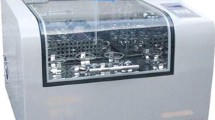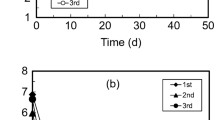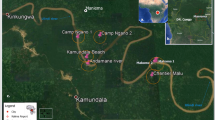Abstract
Purpose
The objective of this study was to investigate the bioleaching of heavy metals from contaminated sediments by Aspergillus niger strain SY1. To achieve this, three targets were identified: (1) identify organic acids produced by the isolated A. niger strain SY1 from contaminated sediments, (2) compare the leaching ability and transformation of chemical speciation of heavy metals during the bioleaching processes, and (3) determine the toxic characteristic of sediment before and after bioleaching.
Materials and methods
The contaminated sediment was collected from the dredging of the Xihe River, China. The A. niger strain SY1 was isolated from this sediment. Bioleaching experiments were carried out in 250 ml autoclaved conical flasks with 10 g autoclaved sediment, 1 ml of spore suspension, and 99 ml culture medium; the flasks were placed in a shaking incubator (220 rpm) at 30 °C for 7 days. Toxicity characteristic leaching procedure (TCLP) tests were carried out according to USEPA-SW846 Method 1311, and the wheat and earthworm toxicity tests were carried out according to OECD “Guidelines for the Testing of Chemicals.” Fractionation of heavy metals was undertaken by the three-step sequential extraction procedure. The metabolites were determined with a HPLC system.
Results and discussion
There was 11.5 % leaching efficiency of Pb from the polluted sediment in the one-step bioleaching process; while in the two-step bioleaching process, the highest extraction efficiency of Pb was 65.4 %. In one-step bioleaching, 93.5 % Cd, 62.3 % Cu, and 68.2 % Zn were leached out; whereas, the highest metal extraction efficiencies of Cd, Cu, and Zn were 99.5, 56, 71.9, and 76.4 %, respectively, in two-step bioleaching. After the bioleaching, the metals remaining in the sediment were mainly found in the stable fractions. Cd, Pb, Cu, and Zn concentrations in extracted liquor of TCLP tests were reduced to far below the levels in two Chinese standards, and the sediment after bioleaching had a lower toxicity on wheat and earthworm.
Conclusions
A. niger strain SY1 can effectively remove heavy metals in contaminated sediment. The bioleaching efficiencies of heavy metals in the two-step bioleaching were better than that in one-step bioleaching. After the bioleaching, metals remaining in the sediment were mainly found in the stable fractions, and the toxicity of it was reduced to a level for it to be used safely in landfill or used in land application. A. niger strain SY1 is a cost-effective, environmentally friendly, and efficient bioleacher of heavy metals.





Similar content being viewed by others
References
Akinci G, Guven DE (2011) Bioleaching of heavy metals contaminated sediment by pure and mixed cultures of Acidithiobacillus spp. Desalination 268:221–226
Arwidsson Z, Johansson E, von Kronhelm T, Allard B, van Hees P (2010) Remediation of metal contaminated soil by organic metabolites from fungi I—production of organic acids. Water Air Soil Pollut 205:215–226
Beolchini F, Fonti V, Rocchetti L, Saraceni G, Pietrangeli B, Dell’Anno A (2013) Chemical and biological strategies for the mobilisation of metals/semi-metals in contaminated dredged sediments: experimental analysis and environmental impact assessment. Chem Ecol 29:415–426
Burckhard SR, Schwab AP, Banks MK (1995) The effects of organic acids on the leaching of heavy metals from mine tailings. J Hazard Mater 41:135–145
Chan BK, Dudeney AW (2008) Reverse osmosis removal of arsenic residues from bioleaching of refractory gold concentrates. Min Eng 21:272–278
Chen SY, Lin JG (2004) Bioleaching of heavy metals from contaminated sediment by indigenous sulfur-oxidizing bacteria in an air-lift bioreactor: effects of sulfur concentration. Water Res 38:3205–3214
Chen SY, Lin JG (2009) Enhancement of metal bioleaching from contaminated sediment using silver ion. J Hazard Mater 161:893–899
Chen CW, Kao CM, Chen CF, Dong CD (2007) Distribution and accumulation of heavy metals in the sediments of Kaohsiung Harbor, Taiwan. Chemosphere 66:1431–1440
De Silva PM, Pathiratne A, van Gestel CA (2009) Influence of temperature and soil type on the toxicity of three pesticides to Eisenia Andrei. Chemosphere 76:1410–1415
Del Mundo DD, Babel S, Parkpian P (2009) Potential for land application of contaminated sewage sludge treated with fermented liquid from pineapple wastes. J Hazard Mater 167:866–872
Deng X, Chai L, Yang Z, Tang C, Tong H, Yuan P (2012) Bioleaching of heavy metals from a contaminated soil using indigenous Penicillium chrysogenum strain F1. J Hazard Mater 233:25–32
Deng X, Chai L, Yang Z, Tang C, Wang Y, Shi Y (2013) Bioleaching mechanism of heavy metals in the mixture of contaminated soil and slag by using indigenous Penicillium chrysogenum strain F1. J Hazard Mater 248:107–114
Escobar B, Buccicardi S, Morales G, Wiertz J (2010) Biooxidation of ferrous iron and sulphide at low temperatures: implications on acid mine drainage and bioleaching of sulphide minerals. Hydrometallurgy 104:454–458
Fang D, Zhang R, Zhou L, Li J (2011) A combination of bioleaching and bioprecipitation for deep removal of contaminating metals from dredged sediment. J Hazard Mater 192:226–233
Karlfeldt Fedje K, Ekberg C, Skarnemark G, Steenari BM (2010) Removal of hazardous metals from MSW fly ash—an evaluation of ash leaching methods. J Hazard Mater 173:310–317
Kim HA, Lee KY, Lee BT, Kim SO, Kim KW (2012) Comparative study of simultaneous removal of As, Cu, and Pb using different combinations of electrokinetics with bioleaching by Acidithiobacillus ferrooxidans. Water Res 46:5591–5599
Krishnamurti GS, Naidu R (2002) Solid-solution speciation and phytoavailability of copper and zinc in soils. Environ Sci Technol 36:2645–2651
Kumar RN, Nagendran R (2007) Influence of initial pH on bioleaching of heavy metals from contaminated soil employing indigenous Acidithiobacillus thiooxidans. Chemosphere 66:1775–1781
Mafi Gholami R, Mousavi SM, Borghei SM (2012) Process optimization and modeling of heavy metals extraction from a molybdenum rich spent catalyst by Aspergillus niger using response surface methodology. J Indus Eng Chem 18:218–222
More TT, Yan S, Tyagi RD, Surampalli RY (2010) Potential use of filamentous fungi for wastewater sludge treatment. Bioresour Technol 101:7691–7700
Mulligan CN, Yong RN, Gibbs BF (2001) An evaluation of technologies for the heavy metal remediation of dredged sediments. J Hazard Mater 85:145–163
Naresh Kumar R, Nagendran R (2009) Fractionation behavior of heavy metals in soil during bioleaching with Acidithiobacillus thiooxidans. J Hazard Mater 169:1119–1126
Oleszczuk P, Hollert H (2011) Comparison of sewage sludge toxicity to plants and invertebrates in three different soils. Chemosphere 83:502–509
Pathak A, Dastidar MG, Sreekrishnan TR (2009) Bioleaching of heavy metals from sewage sludge: a review. J Environ Manage 90:2343–2353
Peng JF, Song YH (2009) The remediation of heavy metals contaminated sediment. J Hazard Mater 161:633–640
Perez-Santana S, Pomares Alfonso M, Villanueva Tagle M, Peña Icart M, Brunori C, Morabito R (2007) Total and partial digestion of sediments for the evaluation of trace element environmental pollution. Chemosphere 66:1545–1553
Qu Y, Lian B, Mo B, Liu C (2013) Bioleaching of heavy metals from red mud using Aspergillus niger. Hydrometallurgy 136:71–77
Ren WX, Li PJ, Geng Y, Li XJ (2009) Biological leaching of heavy metals from a contaminated soil by Aspergillus niger. J Hazard Mater 167:164–169
Sabra N, Dubourguier HC, Hamieh T (2012) Fungal leaching of heavy metals from sediments dredged from the Deûle Canal, France. Adv Chem Eng Sci 2:1–8
Sankaran S, Khanal SK, Jasti N, Jin B, Pometto AL III, Van Leeuwen JH (2010) Use of filamentous fungi for wastewater treatment and production of high value fungal byproducts: a review. Crit Rev Environ Sci Technol 40:400–449
Seh-Bardan BJ, Othman R, Wahid SA, Husin A, Sadegh-Zadeh F (2012) Bioleaching of heavy metals from mine tailings by Aspergillus fumigatus. Bioremed J 16:57–65
Seidel H, Löser C, Zehnsdorf A, Hoffmann P, Schmerold R (2004) Bioremediation process for sediments contaminated by heavy metals: feasibility study on a pilot scale. Environ Sci Technol 38:1582–1588
Silver S, Phung LT (1996) Bacterial heavy metal resistance: new surprises. Annu Rev Microbiol 50:753–789
Simate GS, Ndlovu S, Walubita LF (2010) The fungal and chemolithotrophic leaching of nickel laterites—challenges and opportunities. Hydrometallurgy 103:150–157
Sullivan TS, Gottel NR, Basta N, Jardine PM, Schadt CW (2012) Firing range soils yield a diverse array of fungal isolates capable of organic acid production and Pb mineral solubilization. Appl Environ Microbiol 78:6078–6086
Yang Z, Wang Y, Shen Z, Niu J, Tang Z (2009) Distribution and speciation of heavy metals in sediments from the mainstream, tributaries, and lakes of the Yangtze River catchment of Wuhan, China. J Hazard Mater 166:1186–1194
Acknowledgments
This work was supported by the National Natural Science Foundation of China (21277150,31270540, 31070455, 31370829, 51174239, and 40971184), Ministry of Science and Technology (2011DFA91810), Ministry of Environmental Protection (2012ZX07202-004), the National Science & Technology Pillar Program (2012BAC17B04), Hi-tech research and development program of China (2012AA06A202), Natural Science Foundation of Liaoning Province, China (201102224), Natural Science Foundation of Shenyang City, China (F13-067-2-00), the Geping green action-environmental research and education “123 project” of Liaoning Province, China (CEPF2011-123-1-1), and the State Scholarship Fund organized by China Scholarship Council (CSC2013). The authors would also like to thank Paula McNamee and Dr. Xiaoman Yu for their constant support.
Author information
Authors and Affiliations
Corresponding author
Additional information
Responsible editor: Gijs D. Breedveld
Rights and permissions
About this article
Cite this article
Zeng, X., Wei, S., Sun, L. et al. Bioleaching of heavy metals from contaminated sediments by the Aspergillus niger strain SY1. J Soils Sediments 15, 1029–1038 (2015). https://doi.org/10.1007/s11368-015-1076-8
Received:
Accepted:
Published:
Issue Date:
DOI: https://doi.org/10.1007/s11368-015-1076-8




